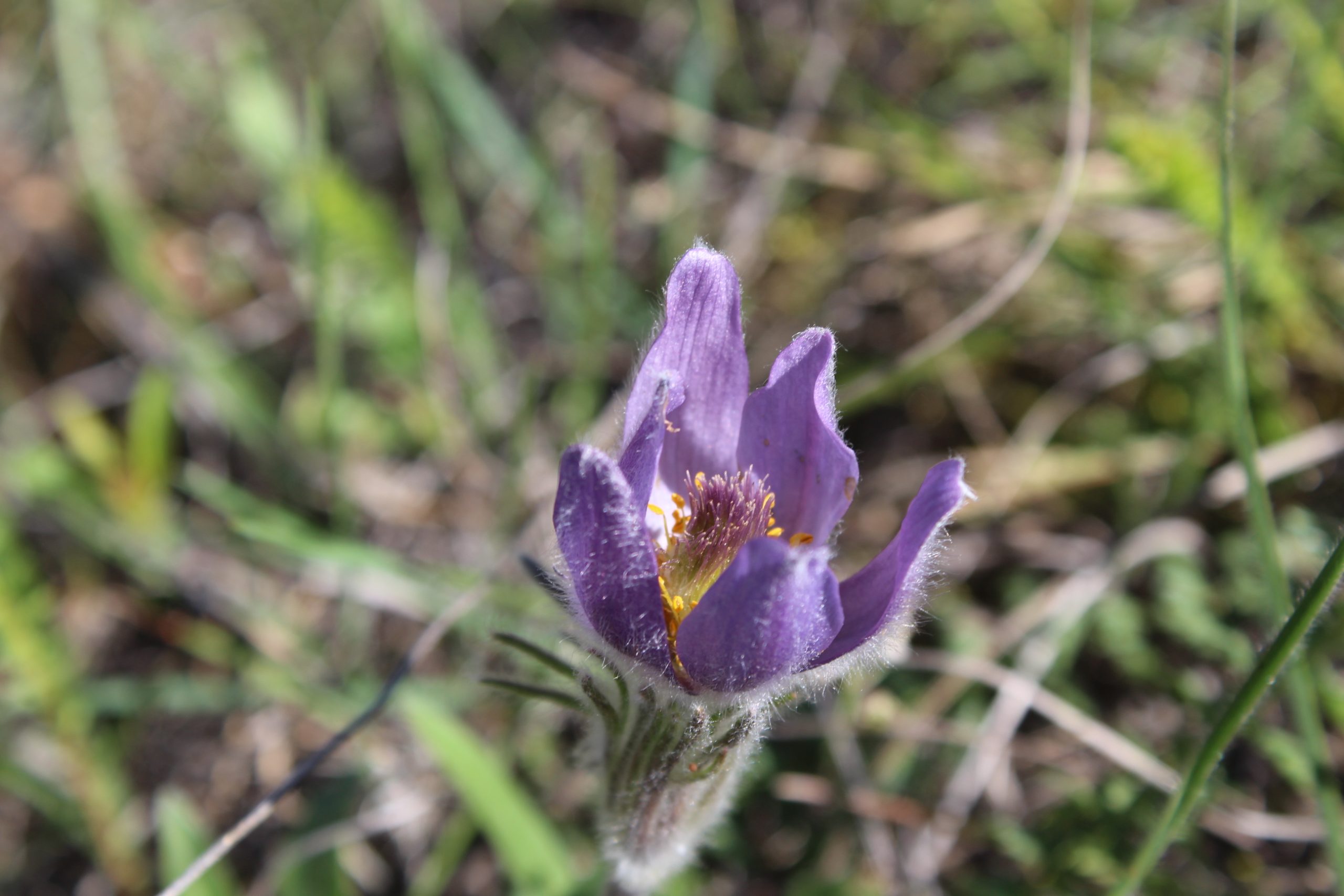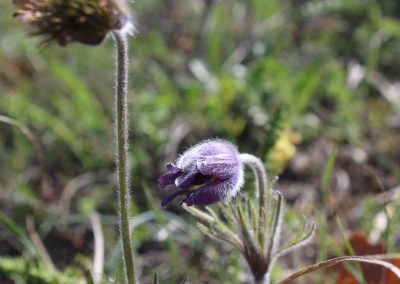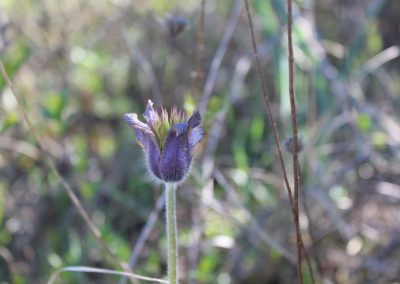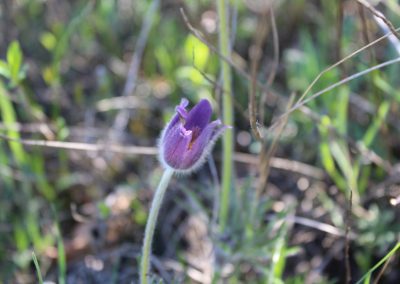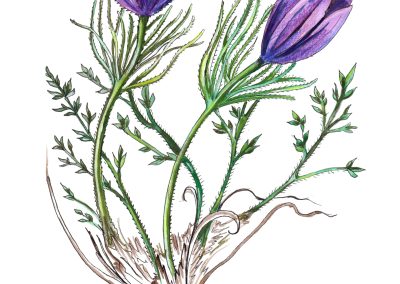Pullsatila Montana
Scientific description
Pulsatilla montana – Pasque Flower / Easter Flower
Division: Angiospermatophyta (Magnoliophyta)
Class: Dicotyledonatae (Magnoliatae)
Subclass: Magnoliidae (Polycarpicae)
Order: Ranunculalaes (Ranales)
Family: Ranunculaceae
Origin: Temperate and cold regions of the Northern Hemisphere
Common name: Pasque Flower, Easter Flower
Description:
Herbaceous, perennial plant, 10–20 cm. Thick rhizome with deep, branched roots. Stem up to 20 cm, hairy. Leaves tripinnate-sect, linear, acute, in rosette. Flowers dark purple, hairy outside, bell-shaped, up to 10 cm, solitary at stem top. Blooms spring in semi-shaded, dry meadows, pastures, steep slopes.
Propagation: Seeds or division of clumps.
Ecology:
Widespread in sunny meadows from steppe zone to beech floor. Prefers semi-shaded areas, humic-clayey soil, moderate humidity.
Use:
Ornamental in parks/gardens, lawns, borders, rockeries. Toxic: protoanemonin causes skin irritation, blisters, redness; affects kidneys/stomach of animals. Medicinal uses: joint rheumatism, neuralgia, migraines, anaphrodisiac.
Danger:
Suffered from reckless harvesting; all parts cause irritation. Protected by law.
Pulsatilla montana – dediței / iarba dracului
Încrengătura: Angiospermatophyta (Magnoliophyta)
Clasa: Dicotyledonatae (Magnoliatae)
Subclasa: Magnoliidae (Polycarpicae)
Ordinul: Ranunculalaes (Ranales)
Familia: Ranunculaceae
Origine: regiunile temperate și reci ale emisferei nordice
Denumire populară: dediței, iarba dracului
Descrierea:
Plantă erbacee, perenă, 10–20 cm, rizom gros cu rădăcini adânci, ramificate. Tulpina până la 20 cm, acoperită cu perișori. Frunzele tripenat-sect, lobii liniari, acuți, în rozetă. Florile violet închis, perișori exteriori, campanulate, mari, până la 10 cm, dispuse singular la vârful tulpinii. Înflorește primăvara, în fânețe semiumbrite, uscate, pășuni, coaste abrupte.
Înmulțire: Semințe sau divizarea tufelor.
Ecologia:
Răspândită în pajiști însorite, din zona de stepă până la etajul fagului. Preferă zone semiumbrite, sol humic-argilos, umiditate moderată.
Utilizare:
Plantă horticolă, decorativă în parcuri și grădini, pentru peluze, borduri, stâncării. Toxică: protoanemonin provoacă iritații, bășici, înroșirea pielii; afectează rinichii și stomacul animalelor. Medicinal: reumatism articular, nevralgie, migrene, anafrodisiac.
Pericol:
Planta a suferit din cauza culegerii nechibzuite. Protejată prin lege.
Pulsatilla montana – Πουλσατίλα
Φυλοταξία: Angiospermatophyta (Magnoliophyta)
Κλάση: Dicotyledonatae (Magnoliatae)
Υποκλάση: Magnoliidae (Polycarpicae)
Τάξη: Ranunculalaes (Ranales)
Οικογένεια: Ranunculaceae
Καθημερινή Ονομασία: Δεδιτζέι, η χλόη του διαβόλου
Προέλευση: Εύκρατες και ψυχρές περιοχές Βόρειας Ημισφαίρου
Περιγραφή:
Πολυετές βότανο, ύψος 10–20 cm, παχιά ρίζα με βαθιές, διακλαδισμένες ρίζες. Στέλεχος έως 20 cm, καλυμμένο με μικρά τριχίδια. Φύλλα τριπλά, λοβοί γραμμικοί, αιχμηροί, σε ροζέτα. Άνθη σκούρο μοβ, τριχωτά εξωτερικά, κουδουνίσια, έως 10 cm, μεμονωμένα στην κορυφή του στελέχους. Ανθίζει άνοιξη, σε ημι-σκιασμένες, ξηρές λιβάδια, βοσκοτόπια και απότομες πλαγιές.
Αναπαραγωγή: Με σπόρους ή διαίρεση θάμνων.
Οικολογία:
Κοινό σε ηλιόλουστα λιβάδια, από ζώνη στέππας μέχρι ορόφους ορεινών δασών. Προτιμά ημι-σκιερά εδάφη πλούσια σε χούμο και άργιλο, μέτρια υγρασία.
Χρήση:
Καλλωπιστικό, πάρκα, κήποι, γκαζόν, βραχώδεις περιοχές. Τοξικό: πρωτοανεμονίνη προκαλεί ερεθισμούς, φουσκάλες, ερυθρότητα δέρματος. Θεραπευτικά: ρευματισμοί, νευραλγίες, πονοκέφαλοι, αντιαφροδισιακό.
Απειλή:
Ζημιές από αλόγιστη συλλογή. Προστατευμένο από το νόμο.
Pulsatilla montana – Fleur de Pasque / Fleur de Pâques
Taxon: Angiospermatophyta (Magnoliophyta)
Classe: Dicotylédones (Magnoliatae)
Sous-classe: Magnoliidae (Polycarpicae)
Ordre: Ranunculalaes (Ranales)
Famille: Ranunculaceae
Origine: Régions tempérées et froides de l'hémisphère nord
Nom commun: Fleur de Pasque, Fleur de Pâques
Description:
Plante herbacée, vivace, 10–20 cm, rhizome épais avec racines profondes et ramifiées. Tige jusqu’à 20 cm, poils. Feuilles tripennées, lobes linéaires, aigus, en rosette. Fleurs pourpre foncé, velues extérieurement, en cloche, jusqu’à 10 cm, solitaires au sommet. Floraison printemps dans prairies semi-ombragées, sèches, pâturages, pentes abruptes.
Propagation: Graines ou division de touffes.
Écologie:
Prairies ensoleillées, de la zone steppique à la hêtraie. Préfère zones semi-ombragées, sol humico-argileux, humidité modérée.
Utilisation:
Ornementale en parcs/jardins, pelouses, bordures, rocailles. Toxique: protoanémonine, irritations, cloques, rougeur cutanée, affecte reins/stomac animaux. Médicinal: rhumatismes articulaires, névralgies, migraines, anaphrodisiaque.
Danger:
Récolte inconsidérée. Toutes parties irritantes. Protégée par la loi.
Creative writing inspired by Pullsatila Montana
Written by Tiberius Saucă
The Cursed Flower
In the past, the Dacian people saw the Wind Flower (Pulsatilla) as a messenger from the world of the dead, since its name, given by the Romans, derives from the Latin pulsare, meaning "to strike" or "to pulse." This, along with the fact that touching the plant causes blisters and skin redness, may have led the Dacians to believe that the world of the dead sent this flower to announce to the living that spring had also arrived in the afterlife.
Thus, the flower was perceived as a "pulse" from the underworld, appearing only in spring, when the connection between the two worlds was believed to be at its strongest. For this reason, it was said that the Dacians would place Wind Flowers on the graves of fallen warriors, to guide them toward the world of the dead in the springtime.
After the formation of the Romanian principalities, especially in Transylvania and the mountainous regions, the Wind Flower became known as "the devil’s herb." Whether due to the stinging sensation it caused when touched or its poisonous nature, the plant became associated with contact with the devil. It was said that the Wind Flower was often used in black magic rituals, and that if a woman wore the flower on her chest, she was considered a witch.
Witches wore the Wind Flower to attract the love of someone, with the belief that the love thus won would blossom like the Wind Flower itself and would be just as hard to break. However, if the flower was picked carelessly or without respect, it was said to bring bad luck in love to the one who gathered it recklessly, once again reflecting its toxic and stinging nature, and reinforcing its reputation as "the devil’s herb."


